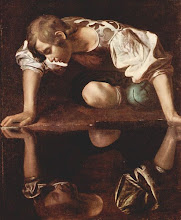 On January 12 Benedict Biscop is commemorated by the Anglican and Roman Catholic churches. Benedict Biscop was the founder of the dual monastery of Monkwearmouth and Jarrow, where Bede lived, studied, and wrote. The monastery's church survived Henry VIII's dissolution of the monasteries and became a parish church. (picture domain manuscript illustration from wikipedia commons)
On January 12 Benedict Biscop is commemorated by the Anglican and Roman Catholic churches. Benedict Biscop was the founder of the dual monastery of Monkwearmouth and Jarrow, where Bede lived, studied, and wrote. The monastery's church survived Henry VIII's dissolution of the monasteries and became a parish church. (picture domain manuscript illustration from wikipedia commons) As well as making passing reference to Benedict Biscop in his Ecclesiastical History of the English People, Bede wrote some biographical notes on Benedict Biscop in his Lives of the Abbots of Monkwearmouth and Jarrow, and described the founding of the monastery as follows:
He [Benedict Biscop]came to the court of Egfrid, king of Northumberland, and gave an account of all that he had done since in youth he had left his country. He made no secret of his zeal for religion, and showed what ecclesiastical or monastic instructions he had received at Rome and elsewhere. He displayed the holy volumes and relics of Christ's blessed Apostles and martyrs, which he had brought, and found such favour in the eyes of the king, that he forthwith gave him seventy hides of land out of his own estates, and ordered a monastery to be built thereon for the first pastor of his church. This was done, as I said before, at the mouth of the river Were, on the left bank, in the 674th year of our Lord's incarnation, in the second indiction, and in the fourth year of King Egfrid's reign.
After the interval of a year, Benedict crossed the sea into Gaul, and no sooner asked than he obtained and carried back with him some masons to build him a church in the Roman style, which he had always admired. So much zeal did he show from his love to Saint Peter, in whose honour he was building it, that within a year from the time of laying the foundation, you might have seen the roof on and the solemnity of the mass celebrated therein. When the work was drawing to completion, he sent messengers to Gaul to fetch makers of glass, (more properly artificers,) who were at this time unknown in Britain, that they might glaze the windows of his church, with the cloisters and dining-rooms. This was done, and they came, and not only finished the work required, but taught the English nation their handicraft, which was well adapted for enclosing the lanterns of the church, and for the vessels required for various uses. All other things necessary for the service of the church and the altar, the sacred vessels, and the vestments, because they could not be procured in England, he took especial care to buy and bring home from foreign parts.
Some decorations and muniments there were which could not be procured even in Gaul, and these the pious founder determined to fetch from Rome; for which purpose, after he had formed the rule for his monastery, be made his fourth voyage to Rome, and returned loaded with more abundant spiritual merchandise than before In the first place, he brought back a large quantity of books of all kinds; secondly, a great number of relics of Christ's Apostles and martyrs, all likely to bring a blessing on many an English church; thirdly, he introduced the Roman mode of chanting, singing, and ministering in the church, by obtaining permission from Pope Agatho to take back with him John, the archchanter of the church t of St. Peter, and abbot of the monastery of St. Martin to teach the English. This John, when he arrived in England, not only communicated instruction by teaching personally, but left behind him numerous writings, which are still preserved in the library of the same monastery. In the fourth place, Benedict brought with him a thing by no means to be despised, namely, a letter of privilege from Pope Agatho, which he had procured, not only with the consent, but by the request and exhortation, of King Egfrid, and by which the monastery was rendered safe and secure for ever from foreign invasion. Fifthly, he brought with him pictures of sacred representations, to adorn the church of St. Peter, which he had built; namely, a likeness of the Virgin Mary and of the twelve Apostles, with which he intended to adorn the central nave, on boarding placed from one wall to the other; also some figures from ecclesiastical history for the south wall, and others from the Revelation of St. John for the north wall; so that every one who entered the church, even if they could not read, wherever they turned their eyes, might have before them the amiable countenance of Christ and his saints, though it were but in a picture, and with watchful minds might revolve on the benefits of our Lord's incarnation, and having before their eyes the perils of the last judgment, might examine their hearts the more strictly on that account.





No comments:
Post a Comment